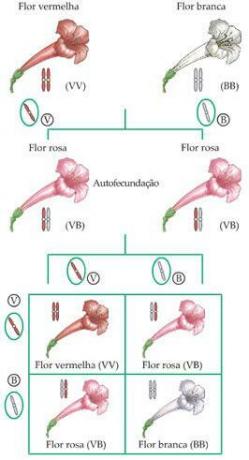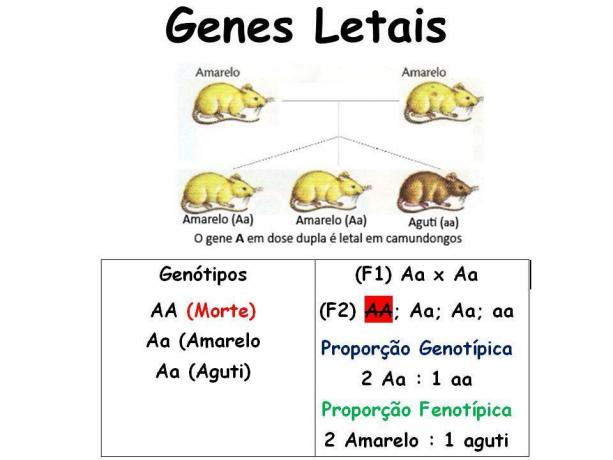
Gregor Mendel (1822-1884) was a great scholar of the 19th century who only gained recognition for his discoveries, more than 30 years after his death, in the early 20th century. The statement of Mendel's First Law was described as: "Each character is conditioned by a pair of factors that are separated in the formation of gametes, in which they occur in single doses".
For Mendel, there were factors that conditioned the characteristics of individuals of the species and these factors could be present pure (AA or aa), where they would be called homozygous, or could present hybrids (Aa), which would be called heterozygous. The traits in these pairs could be dominant (represented by capital letters) or recessive (represented by lowercase letters). When dominant, the characteristic will always be expressed in the individual, however, if it is recessive, this characteristic will only be expressed in the absence of the dominant factor.
see more
Biology teacher fired after class on XX and XY chromosomes;…
Cannabidiol found in common plant in Brazil brings new perspective…
The crosses used by Mendel were very simple. In these experiments he used peas (Pisum sativum), a plant with a large number of seeds, a fast life cycle and plants with distinct characteristics. In order to obtain pure plants, he carried out several crosses with self-fertilization, until he obtained plants capable of producing only seeds of one color. From these plants he crossed the parental generation (P generation) using the male part of a yellow seed plant and the female part of a green seed plant. Mendel obtained an F1 generation with 100% yellow seeds. In the second crossing, he self-fertilized the plants of the F1 generation and obtained a ratio of 3 yellow seeds to 1 green (3:1).
Mendel predicted that factors occur in pairs and are separated in the formation of gametes. Taking this into account, hybrid individuals should form pure gametes with both smooth and wrinkled seed factor, for example. If that happened, the F1 generation of this cross would have individuals with smooth seeds and wrinkled seeds in equal proportions. It happened. It's called a test-cross.
The testcross is used to find out if the individual that has a dominant character is pure or hybrid, for that, it is enough to cross it with a recessive of that characteristic in question. If in this cross we have only one type of offspring, it is dominant; if there are two types of descendants it will be hybrid for that trait. When performed with a recessive parent it is called a backcross.


Gregor Mendel studied traits that always had the effect of a gene's dominance over its allele (Mendel did not use these terms from the genetics, for him they were just “factors”), and with that the seeds presented only one phenotypic alternative for each character (yellow seed or green; smooth or wrinkled seed; etc).
A hybrid can have a phenotype that is the result of the mixing of the effects of each allele, becoming different from the two pure individuals that gave rise to it. This type of relationship between alleles, in which the two are manifested generating a third characteristic is called absence of dominance or co-dominance or intermediate dominance.
This type of dominance is what happens in the flowers of the plant known as Maravilha (genus mirabilis). Maravilha presents an allele gene for white flower and an allele gene for red flower, the hybrid of this plant has pink flowers. Observing the genotypic and phenotypic proportions of this type of cross, we notice that they are equal (1:2:1).
A gene is called lethal when its presence causes the death of the individual, pre or post birth, or causes a very serious deformity that will lead the individual to die. Both dominant and recessive alleles can cause this lethality. When dominant, they can appear in both homozygotes and heterozygotes, and when lethal genes are recessive, they lead the individual to death when they appear in homozygosis.
In mice, we can have yellow fur, when the genes are dominant, or black, when the genes are dominant. genes are recessive. The crossing of two yellow mice heterozygous does not result in the proportion expected by Mendel's First Law (3:1), there are only two yellow offspring for one black. The homozygous yellow embryos are formed, but do not develop, that is, the gene responsible for the yellow coat when it appears in a double dose is lethal for the individual (causes the death of the embryo).
The gene for yellow coat (P) only kills the embryo in a double dose, we can say that it is recessive for lethality in this species, despite being dominant for coat color. The two yellow individuals are Pp and survive, the other individual is black and has a pp genotype. The embryo that did not survive was also yellow but had the PP genotype. Therefore, in the cross where we have a lethal gene, we will not have a Mendelian ratio of 3:1, but a ratio of 2:1.

Denisele Neuza Aline Flores Borges
Biologist and Master in Botany


